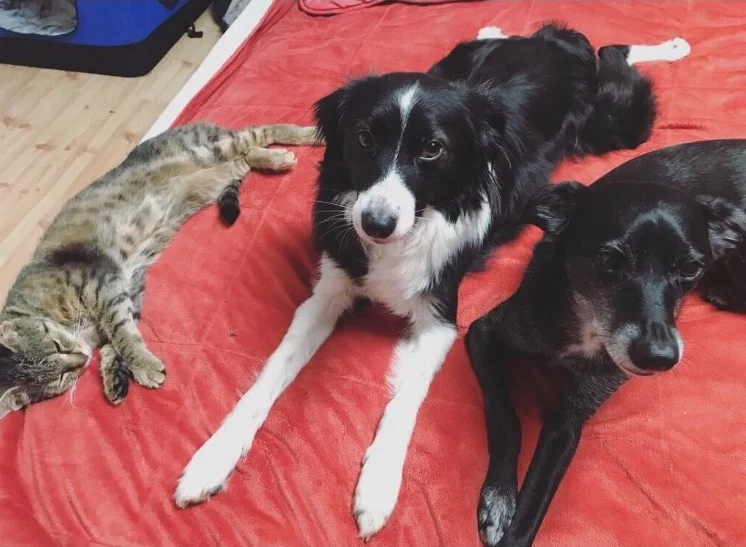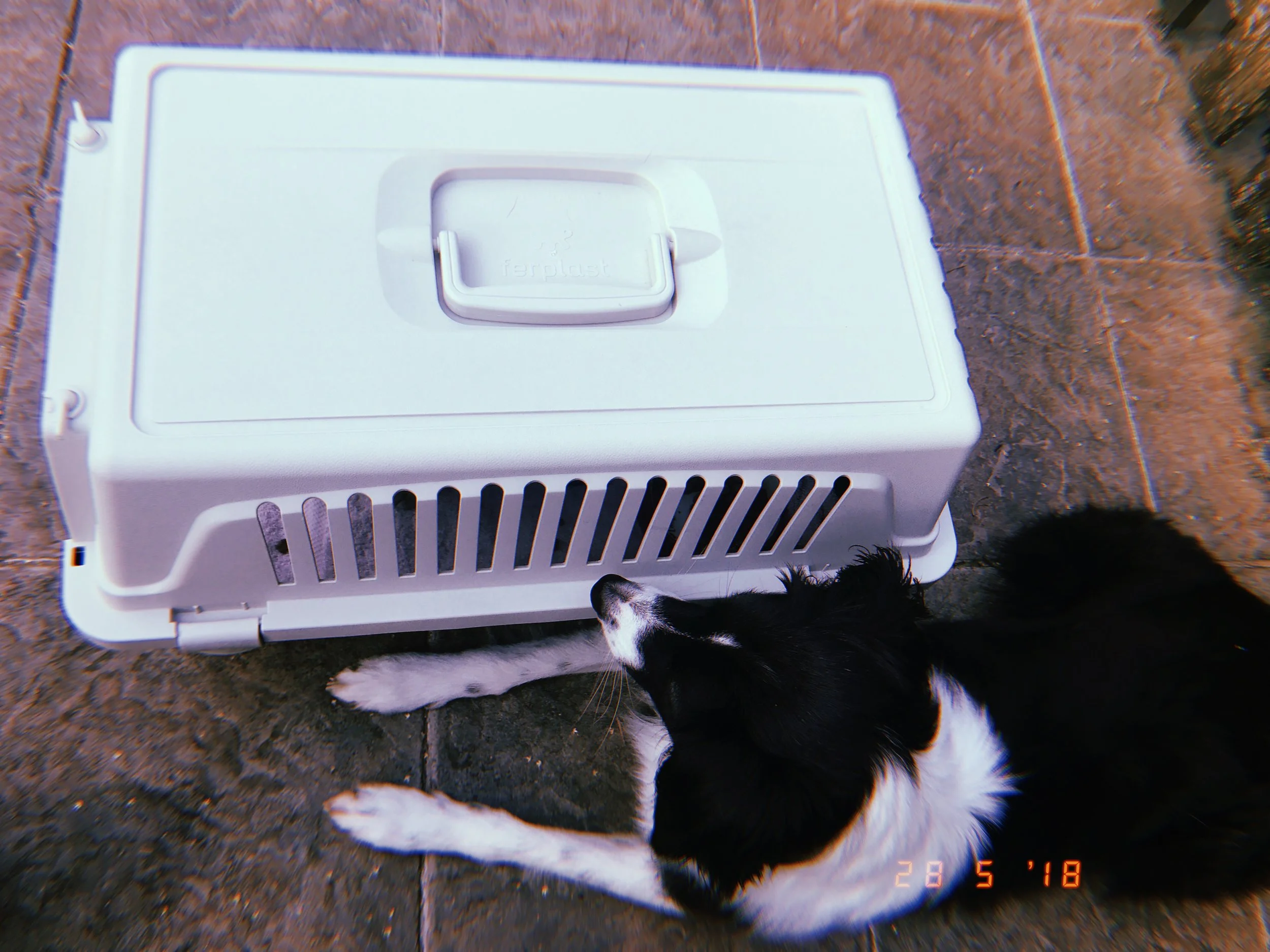Reactive Dogs and Cats: A Socialization Guide [Part 1]
/If someone had told me a few years ago that Bailey will one day be able to peacefully coexist with a cat, I would think it crazy. Cats have always been yet another one of her triggers, but with them it didn’t come from a place of fear, as much as it came from a place of instinct. She has always had an outstanding prey instinct - she’d happily chase squirrels, birds and cats over the edge of a cliff. This is why she’s always been obsessed with chasing the ball and why keeping her prey instinct under control has also proved to help with her reactivity rehabilitation as well.
Even though she and I have already overcame many triggers in our years together, I never dared imagine cats would be one of them. Whenever she saw the stray cat that I am feeding, she’d fly into a hysterical frenzy. She saw her as an intruder on the window and showed her no mercy. So needless to say, when Shadow decided to move in, I was more than just a little worried.
START OUTSIDE OF THE HOME
I took it super slow. The first day of socialization we were outside in our terrace; I put Shadow in Chilly’s giant crate and leashed both dogs on the other side of the terrace. They could see each other but there was no way to reach each other. Bailey did well until Shadow started climbing all over the crate - that was a trigger for her. Rather than trying to “calm her down” I simply took the leash and took Bailey back inside, while Chilly stayed with the cat. The next time, I was prepared and made sure to give Bailey big big big reinforcement every time she looked at me, even if the cat wasn’t doing anything in particular. I was rewarding check-ins. I wasn’t saying any cues to her at all, because I wanted her to observe Shadow in her own rhythm and check-in with me whenever she feels like it.
Side note: these check-ins are a life-saver for reactive dogs! If the reactivity to a certain trigger is so bad that your dog always flips out, teaching him to look at you whenever they sense fear is a super helpful way of managing a situation. Eventually you’ll be able to get closer to the trigger or your dog won’t feel as much fear around it anymore and will be able to look at it without these check-ins altogether!
Bailey did really well with this. Soon after that, I got Shadow her own carrier and we started to uplevel our training. I will admit that we rushed this part a little bit, because Shadow started to come inside the house at that point, so I had to make this top priority. Basically, I put Shadow in a carrier and then I just walked past it with each dog. I reinforced calmness. Chilly, my non-reactive bug, did super well and after a few training sessions didn’t mind the cat at all. Bailey not so much. She was VERY aware of Shadow and we kept our distance at the beginning, then gradually started coming closer until we were able to walk around the carrier completely without Bailey obsessing over the cat. Once we were close enough, both of the dogs sniffed the cat but Bailey much more hesitantly.
I used food as a reinforcer through this entire process and I stand by that 100%. I’ve noticed some trainers speak very ill of using food as a reinforcer, even within the positive reinforcement community. I would like to address here that every dog is different and each case of reactivity is unique. I cannot imagine doing this with Bailey without food. Praise is not enough for her to reinforce a calm behavior and toys get her too hyped. The first time we were able to stand right next to the carrier, she started becoming too hyped about food as well (because the presence of the trigger made her nervous), so we took a step back and started again. At one point I started to use food selectively (meaning I didn’t need to reinforce every single time anymore) and before long, we were able to happily march around the carrier without any food needed at all.
!!! PLEASE REMEMBER !!!
Make sure your reinforcer is not making your already reactive (and therefore nervous) dog even more hyped up.
Don’t be afraid to take a few steps back if you see your dog is getting overwhelmed
My training sessions lasted MINUTES. None of them were longer than 10. I would also advise not to expose your dog to a trigger every single day but in my case, I basically had no choice so I was even more adamant to keep these sessions as short as possible.
You reactive dog will need to decompress afterwards, so make sure they get A LOT of rest.
You are not using food as a bribe or a distraction!!! You are using food as a reinforcer and a way to change your dog’s emotional blueprint.
Example: every time your dog looks at the cat and remains calm, he is immediately reinforced. As you were able to read, in the beginning stages I only reinforced Bailey for check-ins with me, when we still had a big distance between us and the cat. Many would argue why not immediately start by reinforcing her when she looks at the cat. YOU CAN! This is why I said every dog is so unique. My Bailey’s reactivity was so incredibly severe when I got her that she would have a complete meltdown if she so much as sensed, sniffed or heard a trigger. Seeing it would result in an outburst that she could barely snap out of. There are days when I wonder how we ever survived those months and years. As a result of that, she and I have built this check-in system that allows her to first get comfortable around a trigger (without having to look at it) and THEN we move on to getting closer and reinforcing her when she either looks at it or simply remains calm around it. Some people seem to think that if a dog is looking at you he is not paying attention to the trigger - trust me, your dog can still sense the trigger. They’re not stupid.😉
Pay attention to your dog, I don’t care what is written on the internet, even on my blog. Cultivate critical thinking! If some trainer has never worked and lived with your level of reactivity, they can’t know.
An unpopular opinion, I know. But it’s the truth. Watch your dog’s body language at all times and see how he responds to what you are doing together. If you see that he is calming down, you are on a good path. If you see that he is starting to display signs of discomfort (raised hackles, licking lips, lifted paw, whining etc.), get a bigger distance between you and the cat or stop the training session altogether. Maybe your dog has had enough for one day and needs some rest - that is okay!
The last stage of this training was to have Shadow in the carrier placed on a table and the dogs were unleashed around it, together. This step went without any complications at all, perhaps because they weren’t separate in this stage. They went to the table, sniffed the carrier from underneath and then started playing with each other or simply calmed down, stretched on the floor and that was it. Eventually I was able to move the carrier back to the ground, right next to them and all was well. Sometimes they came to briefly sniff Shadow but never both at once and mainly they just left her alone.
TWO IMPORTANT THINGS TO NOTE:
FIRST: my cat Shadow was NEVER afraid of dogs. She has been comfortable around them since she has adopted us, which has made this process outstandingly simpler. In the beginning stages of the socialization I always gave her a big meal in the carrier and she was facing away from the door while I worked with the dogs. She never had a problem with resting in the carrier either - again, this has made my job a lot easier. If this is not the case with your kitten, I would advise the following: first, make sure she is crate trained! Reinforce the living jesus out of a carrier or a crate so that your cat can willingly go inside of it and stay there comfortably. Patience is your best friend here! This training will also come in handy whenever it’s time to take a vet trip, so you’ll be thankful you did it! Second, get a helper. If your cat is not fully comfortable with the dogs then please don’t do this alone. Get someone to help you with the cat as you’re tending to the dogs. They can sit next to the carrier and monitor the cat’s behaviors and emotions, as well as reinforce her with food in the same way you are doing with the dogs. This is how she’ll learn that being around dogs is a short activity that brings her food - and we all know how much kittens love food!
SECOND: this whole outdoor process happened within a two month period. Some steps we breezed over, some steps took longer but just so you know, there is NO TIME-FRAME on how fast this will happen for you. I didn’t have any timeframe set for myself here and it gave me a lot of freedom. Don’t rush this, take it slow if you can. Some situations are unpredictable, as you’ll learn in the Part 2 of this guide; I had to move Shadow into the house full-time overnight. When those situations happen, we push through, we maybe have one or two extra training sessions that we could otherwise leave out but even so, WE NEVER EVER EVER RUSH ANIMALS INTO SOMETHING THAT CAUSES THEM DISCOMFORT or could result in them not trusting us. Our job is to keep them safe!
All socialization truly is, at its core, is making sure our dogs (and cats) feel SAFE in a variety of situations.
Whether you already live with a cat and a reactive dog, or you’re merely thinking about adopting one, please start this process outside of the home on a neutral territory. I know this is a bit of a challenge with a reactive dog, because unless you have a backyard or a terrace, you might not be able to do this. Apartment hallways are terribly stressful for reactive dogs, not to mention parks. If you have the option to drive to a big field or a meadow and have someone with you that could help you, you can still do these sessions outside of the home where you have the ability to keep your dog at any distance that you wish. Again, I urge you to do this even if you already live with a cat and a reactive dog and it’s not working out! We don’t speak this enough but part of what triggers reactive dogs is the notion that they don’t have anywhere to retreat. This is why outside work is so important, because you can build up the distance.
Hopefully this post was able to be of service - this is just Part 1 and it speaks about the work outside of the home. Part 2 will address home manners, cohabiting within a small space, managing your dog’s chase instinct and more! But first, I want you to digest this post and get to work.
Please don’t rush this process and give your animals as much time as they need.
I promise you, it’s all worth it in the end! 🐕❤️🐱
When you’re ready, here’s part 2!




